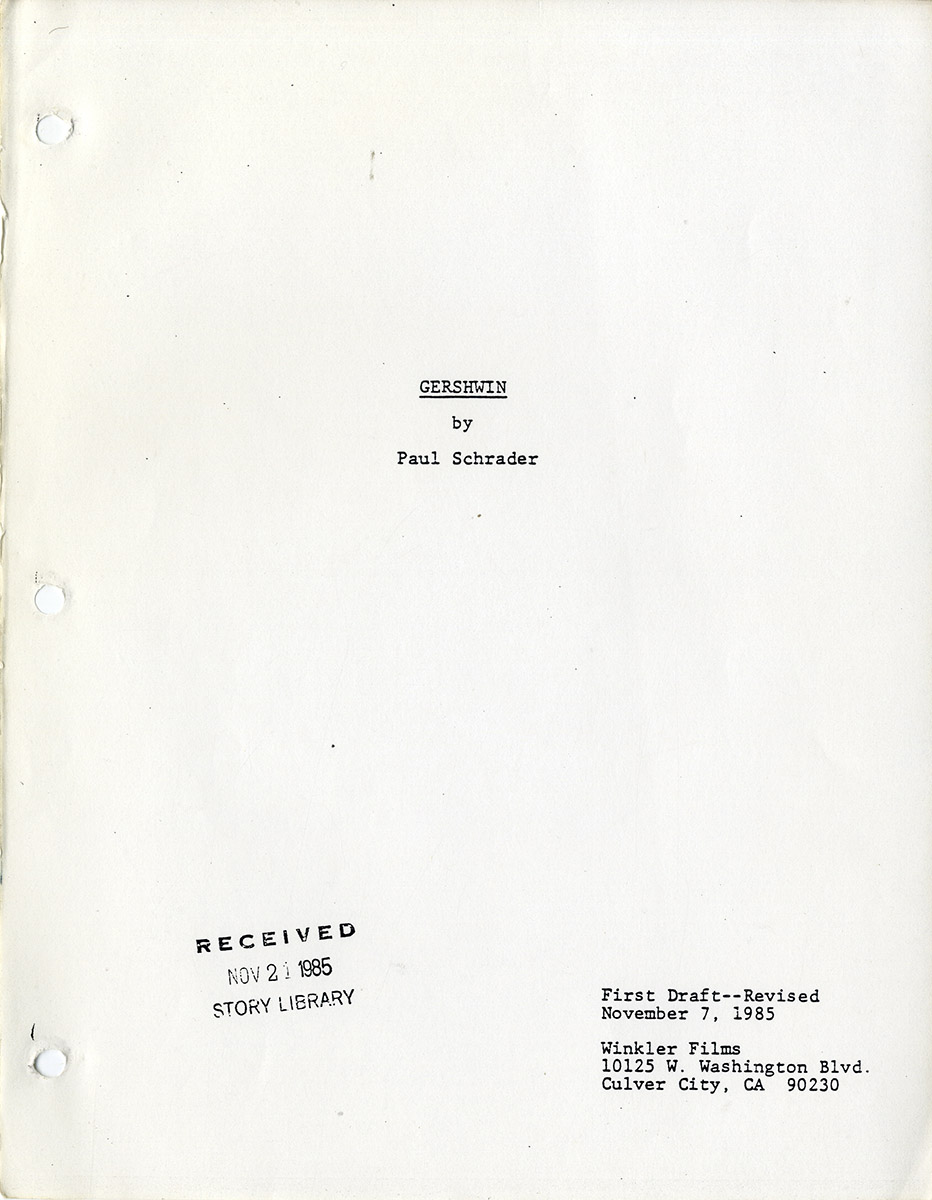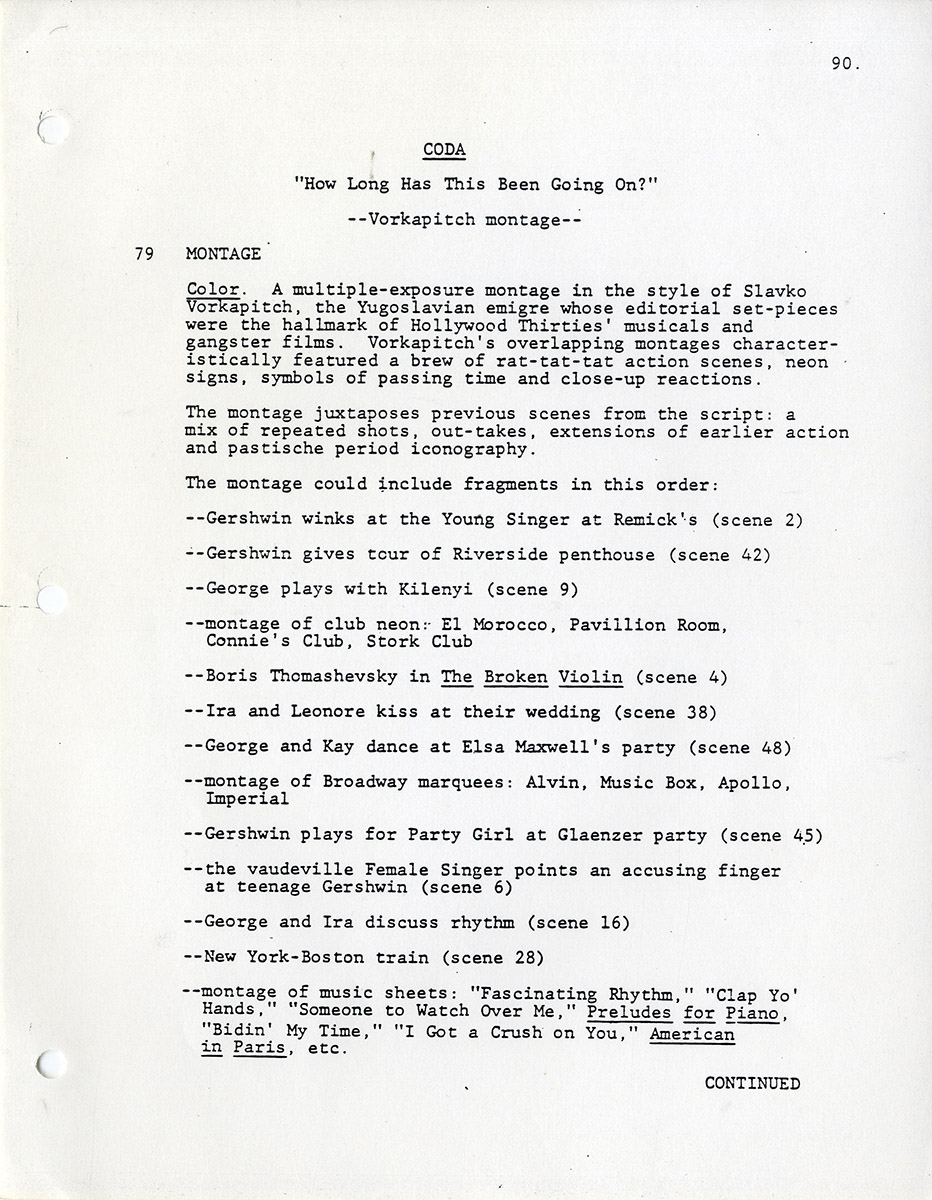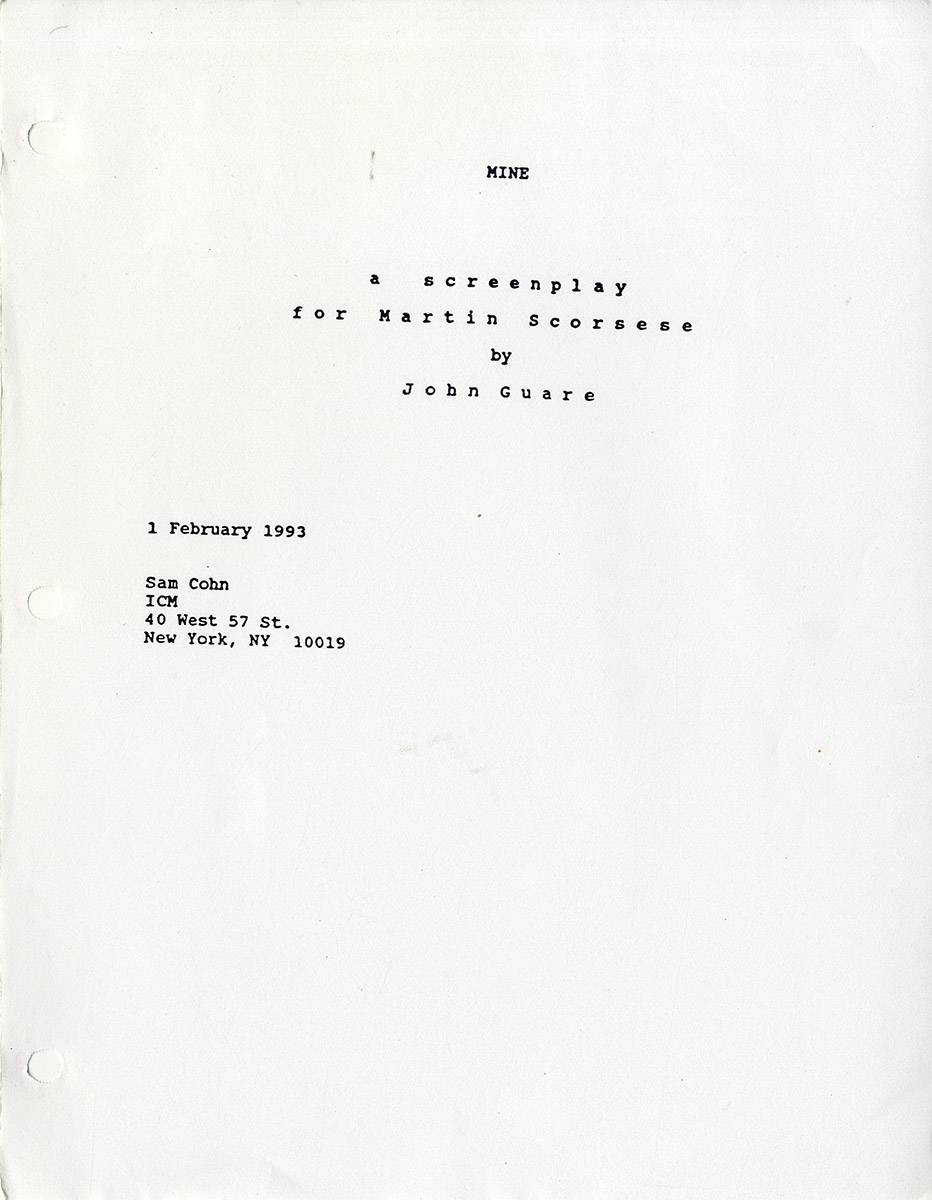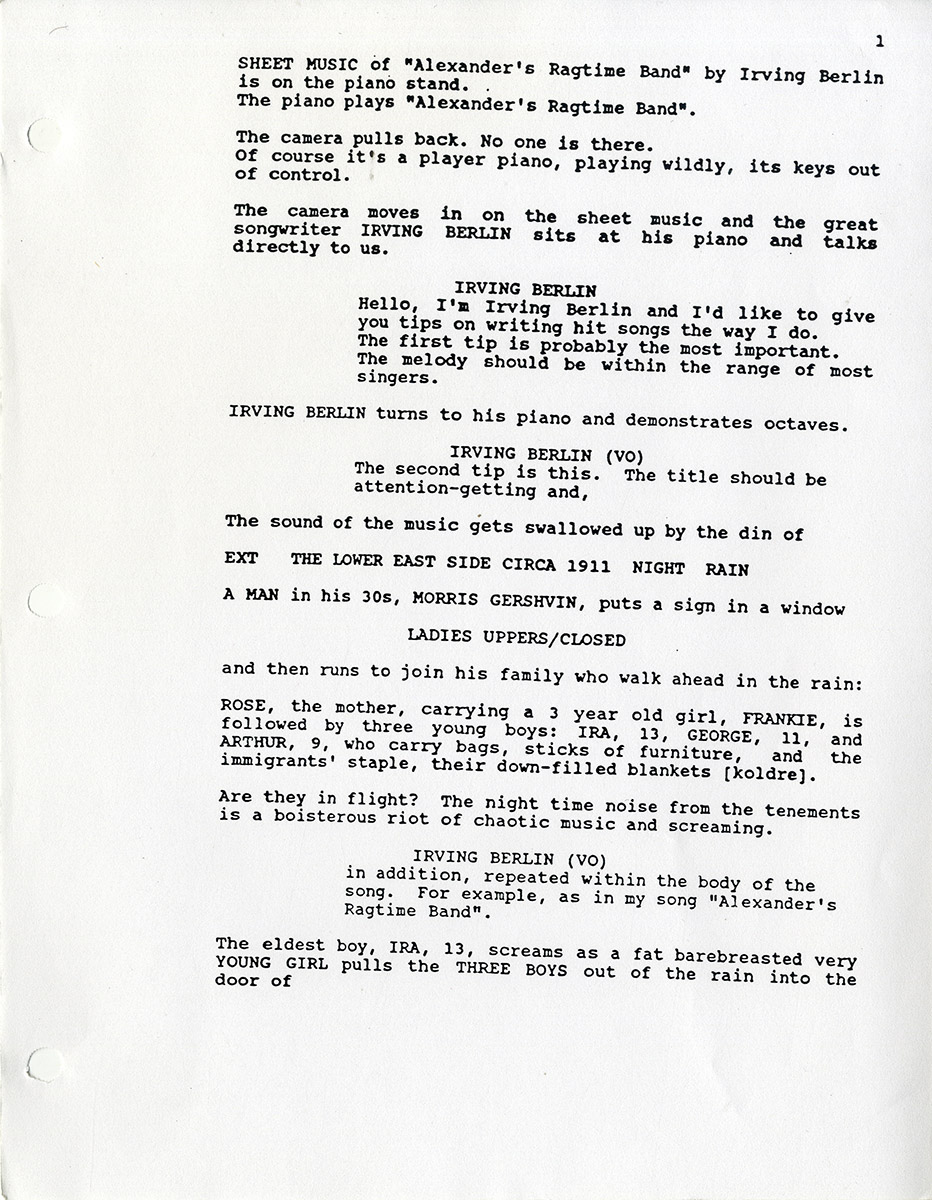Paul Schrader/John Guare (screenplays), Martin Scorsese (director) GERSHWIN (1985; 1993) Set of 2 film scripts
Archive of two vintage original screenplays for an unproduced film, contemporaray production company scripts sent out to possible funders, in plain wrappers (with no photocopied punchholes), 11 x 8 1/2″ (28 x 22 cm.), brad bound, both fine.
— GERSHWIN by Paul Schrader First Draft Revised November 7, 1985. 118 pp. Culver City: Winkler Films, 1985.
One of Martin Scorsese’s most ambitious unrealized projects was a musical biopic of George Gershwin, starring Robert De Niro as Gershwin. Writer/director Paul Schrader, who had previously scripted Taxi Driver and Raging Bull for Scorsese and De Niro, was hired to author the 1985 screenplay. For various reasons — personality conflicts? maybe because it was too expensive? maybe because it was too avant-garde? — the Schrader version was never made.
Paul Schrader’s 1985 film, Mishima: A Life in Four Chapters, was his most formally ambitious directorial achievement to date, divided into chapters that intercut scenes from Mishima’s novels with episodes from his life. Schrader’s Gershwin screenplay, also biographical and written shortly after the release of Mishima, was equally ambitious. Schrader’s conception was to divide Gershwin’s life into nine thematic chapters, the dramatic portion of each chapter to be shot in black-and-white, followed by a musical coda to be shot in color. Skipping back and forth in time, scenes that begin in one chapter continue in subsequent chapters. The nine chapters are as follows:
- Tin Pan Alley — We see George trying to earn a living as a piano player and sheet music salesman in New York’s legendary Tin Pan Alley. His Jewish background. His earliest work as a composer. Chapter concludes with a performance in color of Gershwin’s “I’ll Build a Stairway to Paradise” as staged in George White’s Scandals.
- Ira — Contrasting the extroverted, energetic George Gershwin writing music on a piano, with his quieter brother Ira, who writes the lyrics. Their almost telepathic relationship. The coda, in color, is a performance of “S’Wonderful” in Broadway musical style.
- Rhapsody in Blue — Bandleader Paul Whiteman has the idea of bringing jazz to the concert hall. He commissions George to write the concerto, “Rhapsody in Blue”. The coda, in color, is the premiere of “Rhapsody in Blue” with Whiteman conducting and George on the piano.
- Broadway — Rehearsal and performance of the Broadway musical Funny Face starring Fred and Adele Astaire. George is now living the life of an international celebrity. Coda, in color, is a performance of the title song from George and Ira’s political satire Of Thee I Sing.
- High Society — George is the toast of the town. Highlighted by Elsa Maxwell’s 1929 “Come as Your Opposite” party. Color coda — party guests crowded around George’s piano for a rendition of “Who Cares”.
- Porgy and Bess — George and Ira attempt grand opera, collaborating with Southern playwright DuBose Heyward, on an adaptation of Heyward’s play about Black people, Porgy. The radical idea of performing it with an all-Black singing cast. Color coda — the stage performance of a spiritual choral number from Porgy and Bess.
- Women — George’s many casual affairs. His serious relationship with a married woman, Kay Swift. Color coda — A jazz club torch singer sings, “But Not for Me”.
- Psychoanalysis — George sees a psychiatrist to deal with the recurring stomach pains he thinks are psychosomatic. “The entire chapter is a single, uncut monologue.” Color coda — A montage of images from the previous chapters while on the soundtrack, a “Fifties Sinatra-like voice” sings “How Long Has This Been Going On?”
- Hollywood — George writing music for the movies and dealing with symptoms of the brain tumor that eventually kills him at the age of 38. Color coda — Mark Sandrich directing a scene from the movie Shall We Dance, with Fred Astaire and Ginger Rogers performing the Gershwin classic, “They Can’t Take That Away from Me”, cutting to a scene of George, Ira and Astaire happily belting out the same song at home as George plays it on the piano.
— MINE a screenplay for Martin Scorsese by John Guare. 1 February, 1993. 141 pp.
John Guare (born February 5, 1938) is an American dramatist best known for the plays The House of Blue Leaves and Six Degrees of Separation, and for his original Oscar-nominated screenplay of Louis Malle’s Atlantic City (1980). In the 1990s, Guare was commissioned by Martin Scorsese to write a completely different version of the Gershwin biopic, entitled Mine, which would have starred Robert De Niro as George and Richard Dreyfuss as his brother, Ira.
The most striking difference between the Schrader and Guare screenplays is that Guare’s script looks at George’s life through Ira’s eyes. Ira is effectively the main character. Where Schrader’s script is composed of thematic blocks, the Guare script has a traditional linear narrative. We begin with Ira, George, brother Arthur and sister Frankie as children in New York’s Lower East Side, and proceed chronologically from there. Only occasionally does the script cut to the future, Ira in 1937 after George’s death telling his story to a psychiatrist. Where Schrader’s script borders on the avant-garde, Guare’s script feels comparatively retro, like a Warner Brothers film from the 1940s starring John Garfield as Ira and Robert Alda (who actually played Gershwin in a biopic) as George.
Where Schrader’s screenplay carves out space for big musical production numbers, one at the end of each of its nine chapters, the Guare script integrates the music with the narrative, usually with George playing piano.
The relationship between the brothers is also presented differently. When young, Ira, an aspiring writer, considers himself to be the genius of the family, and only gradually comes to realize how talented his younger brother is. Where Schrader described the relationship between the brothers as telepathic, in Guare’s script they are rivals. Guare emphasizes their relationships and work with others — George as a composer, Ira as a lyricist — before they eventually team up in the story’s second half. Even then, Ira feels overshadowed by George’s fame until Ira wins a Pulitzer Prize — that he pointedly does not share with George — for writing the lyrics of the 1932 political musical, Of Thee I Sing. It’s possible that the rivalry between the brothers, like the tension between the brothers in Raging Bull, was closer to Scorsese’s sensibility than the more harmonious relationship presented in Schrader’s screenplay.
At the end of Guare’s script, Ira speculates that if George had not died so young, he would have been remembered primarily for a lifetime of classical composing, with the songs a mere prelude. The most striking similarity between the Schrader script and the Guare script is that they both end with the song, “They Can’t Take That Away from Me”.
At the same time Scorsese was developing Guare’s Gershwin script for Warner Brothers, he was also developing a movie about the life of Dean Martin, which the studio elected to support instead of the Gershwin project. Ultimately, neither film was made.
Out of stock
Related products
-
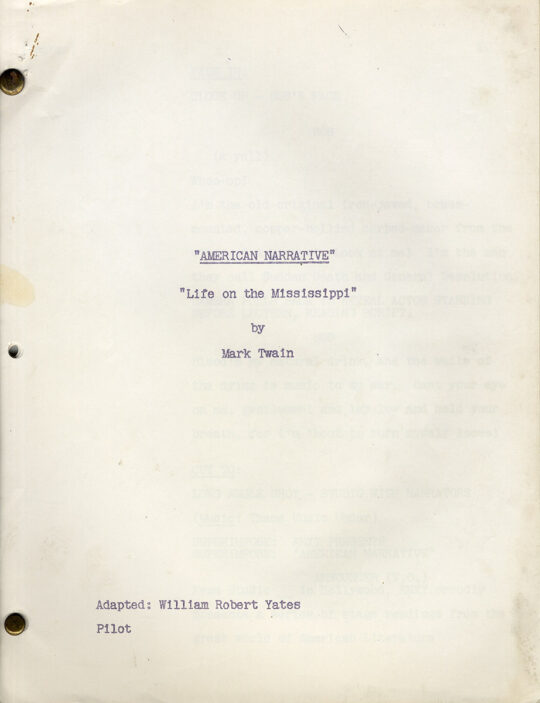
Mark Twain (source) LIFE ON THE MISSISSIPPI (ca. 1956) TV script adapted by William Robert Yates
$300.00 Add to cart -
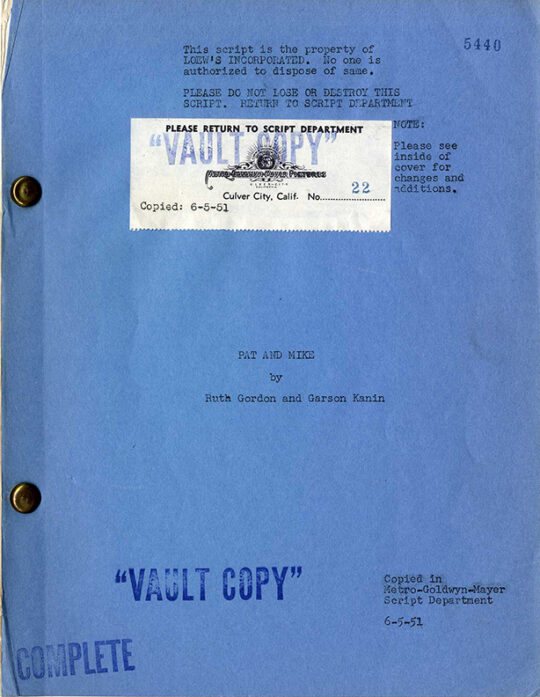
PAT AND MIKE (Jun 6, 1951) Film script by Ruth Gordon, Garson Kanin
$2,500.00 Add to cart -
![LES CREATURES [THE CREATURES] (1966) French film script](https://www.walterfilm.com/wp-content/uploads/2021/04/LesCreaturesSCR_a-540x689.jpg)
Agnès Varda (screenwriter, director) LES CRÉATURES (1966) Film script
$1,500.00 Add to cart -
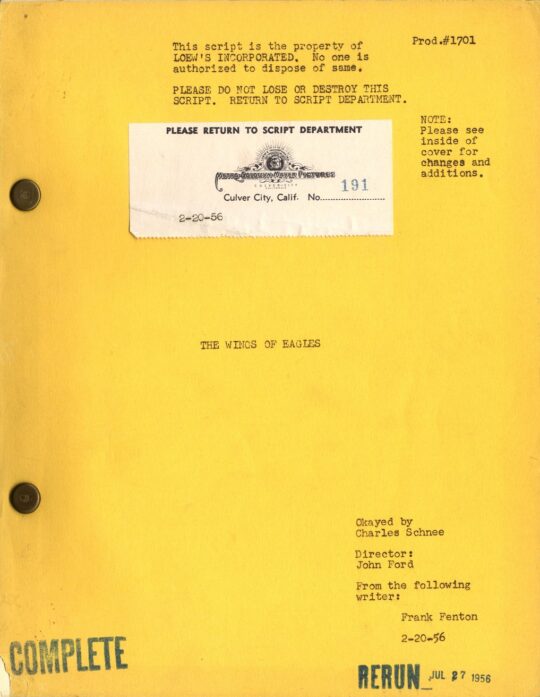
WINGS OF EAGLES, THE (1957) Two variant film scripts
$2,650.00 Add to cart

